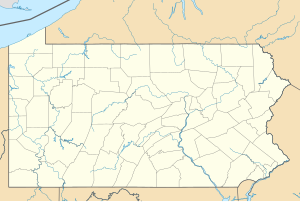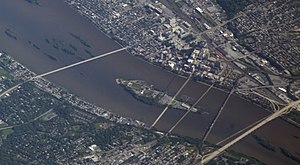Market Street Bridge (Susquehanna River, Harrisburg)
Coordinates: 40 ° 15 ′ 24 ″ N , 76 ° 53 ′ 5 ″ W.
| Market Street Bridge | ||
|---|---|---|
| East side of the bridge between Harrisburg and City Island | ||
| use | Road bridge | |
| Crossing of | Susquehanna River | |
| place | Harrisburg and Wormleysburg , Pennsylvania | |
| Entertained by | PennDOT | |
| construction |
Arch Bridge (East Side) Girder Bridge ( City Island) Girder Bridge ( West Side) |
|
| overall length | 431 m (east side) 26 m (City Island) 433 m (west side) |
|
| width | 18 m | |
| Longest span | 27 m | |
| completion | 1928 (1962, 2006) | |
| planner |
Modjeski & Masters Paul Philippe Cret |
|
| location | ||
|
|
||
| Harrisburg with City Island on Susquehanna | ||
|
The bridges at the level of the river island from left to right: M. Harvey Taylor Memorial Bridge Walnut Street Bridge Market Street Bridge Cumberland Valley Railroad Bridge Philadelphia and Reading Railroad Bridge ( Dock Street Dam ) John Harris Bridge |
||
The Market Street Bridge is a four-lane road bridge over the Susquehanna River between Harrisburg and Wormleysburg in the state of Pennsylvania in the USA . It runs over the river island City Island , by which it is divided into two approximately 430 meter long sections. The east side to Harrisburg was completed in 1928 as a four-lane arched bridge , with the steel girder girders of the two-lane preceding bridge being transported to the west side and combined with the existing four-lane connection to Wormleysburg. This superstructure was replaced in 1962 by the current beam bridge made of reinforced concrete .
The bridge is operated by the Pennsylvania Department of Transportation (PennDOT) and the average traffic volume in 2017 was approximately 13,400 vehicles per day. The arch bridge on the east side was listed as a historical monument in 1988 by being included in the National Register of Historic Places (NRHP #: 88000759).
history

The first bridge over the Susquehanna was built by Theodore Burr for the Harrisburg Bridge Company between 1812 and 1817. There was a covered wooden bridge in the name of its designer Burr Truss design that just outside of Harrisburg on the river island City Iceland went and because of their appearance as Camelback Bridge (dt. " Camel -back Bridge") got known. The first railway bridge of a similar construction followed downstream in the immediate vicinity by 1839 . Both bridges were repeatedly victims of the forces of nature in the 18th century and had to be partially or completely rebuilt over the years. Considerable damage from flooding when the snow melts the spring of 1902, a repair of getting on in years made Camelback Bridge unprofitable, whereupon the Harrisburg Bridge Company for the construction of a new steel - girder bridge with solid wall beams decided, which could be completed by February 1904th
Although the neighboring railway bridge could also be used by wagons and pedestrians for a few years, the operating company of the Camel Back Bridge had an undisputed monopoly for decades. High tolls and the increase in traffic due to the development of the city of Harrisburg and its rural surroundings led to the founding of The People's Bridge Company of Harrisburg at the end of the century , which upriver built the current Walnut Street Bridge by 1890 . A bitter price war ensued, which subsequently significantly lowered the tolls on both bridges and further promoted the region's development. In the early 1920s, the then two-lane girder bridge had to be upgraded to four lanes, for which the engineering office Modjeski & Masters was hired, which worked together with the architect Paul Philippe Cret until March 1924 to develop drafts for the conversion. The Harrisburg Bridge Company decided on a reinforced concrete - arch bridge with stone facade for the eastern part of the bridge (between Harrisburg and City Iceland), where the existing beam support should continue to be used for the western section to give as a continuous four-lane connection to Wormleysburg on the west bank. Construction began in 1926 and was completed two years later.
The state of Pennsylvania purchased the bridge in October 1949 for 3.85 million US dollars and was able to lift the toll in May 1957 after collecting the purchase price. The western part was rebuilt in 1962 by Department of Highways (predecessor of PennDOT) into today's reinforced concrete girder bridge. Today six bridges cross the Susquehanna at the level of the river island, with the neighboring Walnut Street Bridge only partially usable as a bicycle and footpath and the Cumberland Valley Railroad Bridge has been closed.
Second Market Street Bridge in 1906, Walnut Street Bridge on the left
description

The Market Street Bridge is now divided into the 431 m long arch bridge on the east side from 1928, consisting of 16 arches with a span of around 21 m each. The usable width of 17.6 m offers space for four lanes and a walkway of 2 m on the outside. The massive pillars with their round edge protection are 24 m long and 3.7 m wide. The connection to the west side via the river island City Island is realized by an earth wall, interrupted by a short prestressed concrete girder bridge over a connecting road to the island, built in 2006 with a span of 25.9 m. The west side of the bridge between the river island and Wormleysburg consists of a box girder bridge with a length of 433 m, which, like the arch bridge, has 16 spans of around 21 m and also has four lanes and outer walkways.
literature
- Hubertis M. Cummings: Theodore Burr and his bridges across the Susquehanna. In: Pennsylvania History. Vol. 23, No. 4, 1956, pp. 476-486.
- Blythe Semmer: Market Street Bridge, Pennsylvania Historic Bridges Recording Project. Historic American Engineering Record, HAER No. PA-455, Washington, DC 1997.
- Erik V. Fasick: Harrisburg and the Susquehanna River. Images of America, 2015, ISBN 978-1-4671-2298-6 , pp. 15-32.
Web links
- Market Street Bridge, Spanning East channel of Susquehanna River at Market Street (State Route 3012), Harrisburg, Dauphin County, PA. Historic American Engineering Record , HAER No. PA-455.
Individual evidence
- ↑ a b State Bridges Listing as of July 2017. Open Data PA, Commonwealth of Pennsylvania (Bridge Reference Numbers: 14529, 44005 and 14531). Retrieved January 2, 2018.
- ↑ Market Street Bridge. NPGallery Digital Asset Management System, National Park Service. Retrieved January 5, 2018.
- ^ A b Blythe Semmer: Market Street Bridge, Pennsylvania Historic Bridges Recording Project. Historic American Engineering Record, HAER No. PA-455, Washington, DC 1997, pp. 6-9.
- ^ Richard M. Casella: Walnut Street Bridge, Pennsylvania Historic Bridges Recording Project. HAER No. PA-412, Washington, DC 1996, pp. 5-11.
- ^ A b Blythe Semmer: Market Street Bridge, Pennsylvania Historic Bridges Recording Project. Historic American Engineering Record, HAER No. PA-455, Washington, DC 1997, pp. 2-6.
- ↑ Sean Adams: Do you know your Central Pa. bridges? Stats on the major Susquehanna River crossings. PennLive March 23, 2017. Retrieved January 4, 2018.




